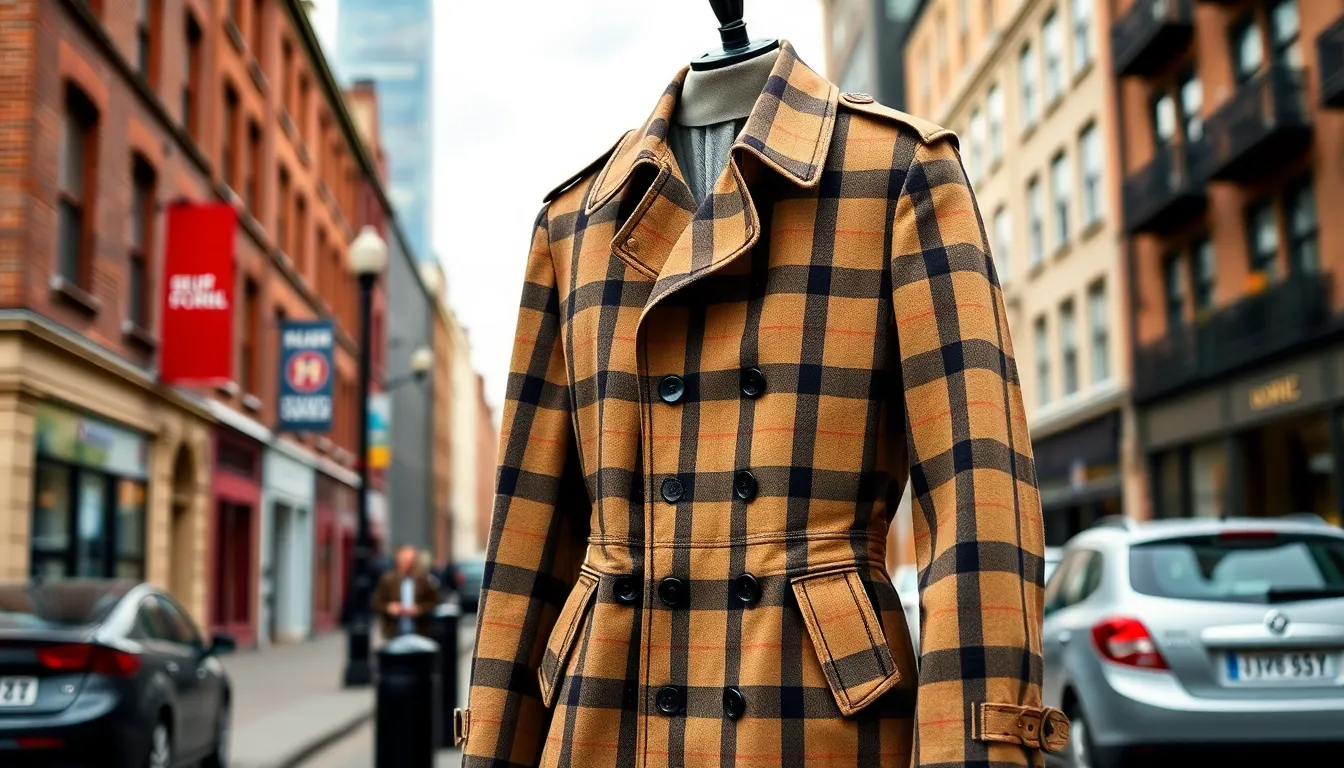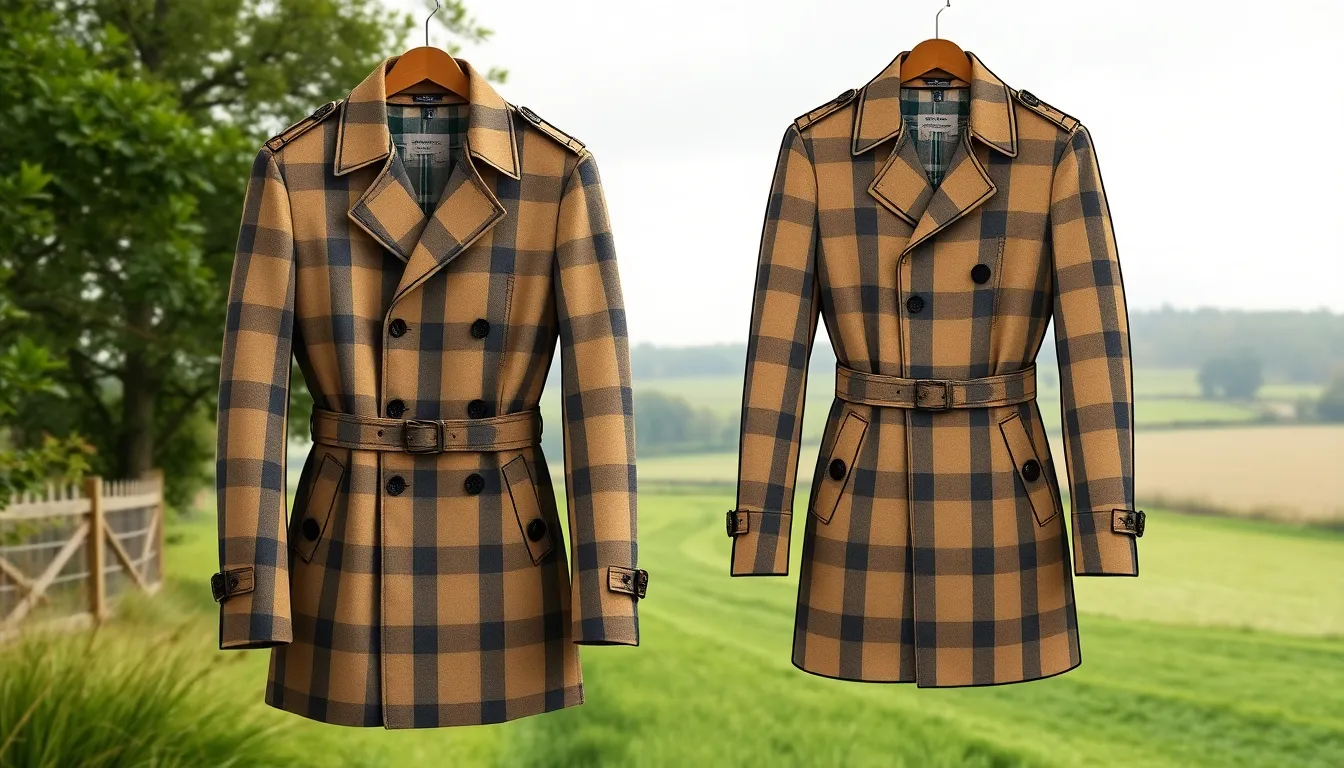Burberry design isn’t just about fashion; it’s a British institution that’s woven into the very fabric of style. Imagine strutting down the street, wrapped in a timeless trench coat that screams sophistication while whispering, “I’ve got taste.” With its iconic check pattern and luxurious materials, Burberry has mastered the art of blending tradition with modern flair, making it a go-to for fashionistas and trendsetters alike.
But let’s be honest—who wouldn’t want to look like they just stepped off a runway? Whether it’s the classic outerwear or the daring accessories, Burberry’s design ethos is all about making a statement. So buckle up as we dive into the world of Burberry, where elegance meets a cheeky twist, and every piece tells a story that’s just waiting to be worn.
Burberry Design
Burberry design showcases a powerful blend of heritage and innovation. Known for its distinct tartan patterns, the label utilizes a rich history to craft contemporary pieces. Iconic trench coats demonstrate the brand’s commitment to quality and craftsmanship. These coats often incorporate high-performance materials, balancing practicality with style.
The signature check pattern remains a staple across various collections. This unique element symbolizes British luxury and resonates with a global audience. Designs frequently feature bold colors and innovative textures, appealing to both traditionalists and modern fashion enthusiasts. Burberry consistently emphasizes attention to detail, evident in the meticulous tailoring of its garments.
Fashion shows reveal how Burberry pushes creative boundaries while retaining classic elements. Each new collection invites exploration of fresh silhouettes and styles. Accessories, such as bags and scarves, complement the apparel, enhancing the brand’s overall aesthetic.
Sustainability has become a focal point in recent designs. Burberry actively seeks eco-friendly materials and processes, reflecting a commitment to responsible fashion. This approach attracts environmentally conscious consumers who value style and ethical considerations.
Underlying all Burberry designs is a narrative that connects history to present-day trends. The fusion of practicality and aesthetic appeal continues to resonate, establishing Burberry as a leader in the fashion industry. In every collection, the brand remains dedicated to creating pieces that not only represent a legacy but also embody contemporary luxury.
History of Burberry Design


Burberry’s design history reflects a rich lineage of innovation and tradition. The brand’s journey begins in the 19th century, marked by a commitment to quality and functionality.
Founding of Burberry
Burberry was founded in 1856 by Thomas Burberry in Basingstoke, England. The designer initially focused on creating outerwear that catered to the needs of explorers and outdoor enthusiasts. His invention of gabardine, a water-resistant fabric, marked a significant milestone, setting a new standard for functional fashion. This fabric provided durability and comfort, allowing for greater freedom of movement. Establishing a reputation for reliability and craftsmanship, Burberry quickly captured the attention of the British military and outdoor adventurers.
Evolution Through the Decades
The brand has undergone significant transformations since its inception. In the early 20th century, Burberry introduced the iconic trench coat, which became synonymous with British fashion. The trench coat’s design, inspired by military uniforms, incorporated functional details like epaulets and deep pockets. During the mid-20th century, Burberry solidified its status as a luxury brand through its distinctive check pattern, which appeared prominently on its products. This signature tartan became a symbol of British heritage, appealing to fashion-forward consumers worldwide. As the decades progressed, Burberry embraced modernity by experimenting with bold designs, setting trends that resonate with contemporary style seekers.
Key Elements of Burberry Design
Burberry design captures a unique fusion of heritage and modernity through its distinguished elements. Elements such as patterns, fabrics, color palettes, and textures play significant roles in defining the brand’s identity.
Iconic Patterns and Fabrics
The distinctive check pattern serves as a hallmark of Burberry fashion. Known globally, this tartan signifies British luxury while reflecting timeless elegance. Gabardine, a fabric invented by Thomas Burberry, adds to the brand’s allure with its water-resistant properties. Trench coats and outerwear feature this innovative material, showcasing functionality alongside style. Customers appreciate the durability and comfort, which elevate everyday pieces into luxurious statements. Patterns and fabrics intertwine to create a cohesive aesthetic admired by fashion enthusiasts worldwide.
Color Palettes and Textures
Burberry embraces a diverse range of color palettes, from classic neutrals to bold hues. Earthy tones dominate the collections, providing versatility for various styling options. The playful use of color draws attention while complementing traditional elements. Textures also play a vital role, with soft cashmeres and rugged wools enhancing visual and tactile appeal. Each collection incorporates textures that evoke sophistication and warmth. Together, these color palettes and textures embody the brand’s commitment to marrying classic designs with contemporary flair.
The Influence of Burberry Design on Fashion
Burberry’s design significantly shapes the fashion landscape, blending luxury with innovation. Its influence extends beyond clothing, defining trends in the luxury segment.
Impact on Luxury Fashion
Burberry’s commitment to quality craftsmanship sets a high standard in luxury fashion. The brand’s iconic trench coats exemplify elegance and functionality, appealing to discerning consumers. Recognizing its heritage, Burberry embodies British culture while evolving with contemporary styles. Designers frequently draw inspiration from Burberry’s distinctive check pattern and versatile fabrics. This blend of tradition and modernity influences emerging designers seeking to make their mark. The brand’s ability to balance classic silhouettes with fresh designs secures its status as a leader in the luxury market. Burberry’s designs attract loyal customers and inspire fashion houses globally, establishing benchmarks for quality and style.
Collaborations and Partnerships
Collaborations define Burberry’s innovative approach to fashion. Partnerships with high-profile designers and artists expand the brand’s creative horizons. Notable collaborations showcase unique interpretations of Burberry’s signature style, merging artistic visions with timeless luxury. Limited-edition collections often generate significant buzz, attracting attention from influencers and trendsetters. Collaborations with contemporary brands increase Burberry’s reach and relevance, appealing to younger audiences. Seasonal collections frequently feature exclusive designs that highlight Burberry’s ethos while embracing modern influences. These strategic partnerships reinforce Burberry’s position as an innovator in luxury fashion, ensuring a dynamic presence in a competitive market.
The Future of Burberry Design
Burberry’s future design direction hinges on its commitment to sustainability and innovation. Brands shift towards responsible practices, and Burberry leads the way.
Sustainability Efforts
Burberry actively pursues eco-friendly materials and sustainable practices. Materials like recycled polyester and organic cotton comprise various collections. Emphasis on reducing carbon footprints aligns with the brand’s broader goals. Customers increasingly demand transparency, and Burberry responds by showcasing production processes. Achievements in sustainability include the “Burberry Beyond” initiative, which focuses on responsible sourcing. This initiative targets reducing waste and embracing circular fashion. Burberry’s dedication to creating a positive environmental impact strengthens its appeal among conscious consumers.
Innovations in Design
Innovative design remains central to Burberry’s identity. The brand adopts cutting-edge technology like 3D printing, enhancing the creative process. Collaborations with contemporary artists also push creative boundaries. Fresh silhouettes and unexpected patterns consistently emerge from each new collection. Consumer feedback plays a vital role in guiding design choices, ensuring modern relevance. Use of advanced materials distinguishes products, enabling the balance between functionality and style. Burberry’s ongoing pursuit of innovation secures its position at the forefront of luxury fashion.
